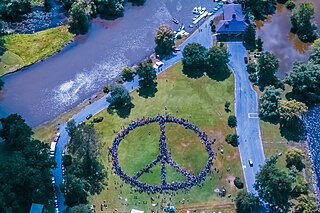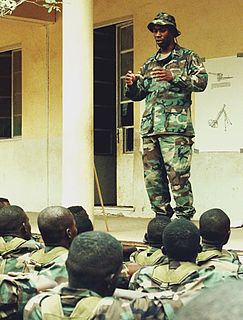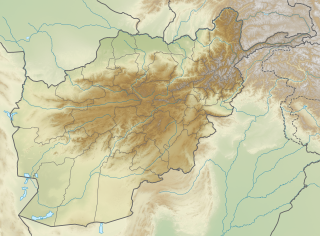The SANS Institute is a private U.S. for-profit company founded in 1989 that specializes in information security, cybersecurity training, and selling certificates. Topics available for training include cyber and network defenses, penetration testing, incident response, digital forensics, and auditing. The information security courses are developed through a consensus process involving administrators, security managers, and information security professionals. The courses cover security fundamentals and technical aspects of information security. The institute has been recognized for its training programs and certification programs. SANS stands for SysAdmin, Audit, Network, and Security.
Information warfare (IW) is a concept involving the battlespace use and management of information and communication technology (ICT) in pursuit of a competitive advantage over an opponent. Information warfare is the manipulation of information trusted by a target without the target's awareness so that the target will make decisions against their interest but in the interest of the one conducting information warfare. As a result, it is not clear when information warfare begins, ends, and how strong or destructive it is. Information warfare may involve the collection of tactical information, assurance(s) that one's information is valid, spreading of propaganda or disinformation to demoralize or manipulate the enemy and the public, undermining the quality of the opposing force's information and denial of information-collection opportunities to opposing forces. Information warfare is closely linked to psychological warfare.

John Richard Boyd was a United States Air Force fighter pilot and Pentagon consultant during the second half of the 20th century. His theories have been highly influential in military, sports, business, and litigation strategies and planning.

The military–industrial complex (MIC) describes the relationship between a nation's military and the defense industry that supplies it, seen together as a vested interest which influences public policy. A driving factor behind this relationship between the government and defense-minded corporations is that both sides benefit—one side from obtaining war weapons, and the other from being paid to supply them. The term is most often used in reference to the system behind the military of the United States, where it is most prevalent due to close links between defense contractors, the Pentagon and politicians and gained popularity after a warning on its detrimental effects in the farewell address of President Dwight D. Eisenhower on January 17, 1961.

Troops for the invasion came primarily from the United States, the United Kingdom and Poland, but 29 other nations also provided some troops, and there were varying levels of assistance from Japan and other countries.

The Pentagon Papers, officially titled Report of the Office of the Secretary of Defense Vietnam Task Force, is a United States Department of Defense history of the United States' political and military involvement in Vietnam from 1945 to 1967. The papers were released by Daniel Ellsberg, who had worked on the study; they were first brought to the attention of the public on the front page of The New York Times in 1971. A 1996 article in The New York Times said that the Pentagon Papers had demonstrated, among other things, that the Johnson Administration had "systematically lied, not only to the public but also to Congress."

An insurgency is a violent, armed rebellion against authority when those taking part in the rebellion are not recognized as belligerents. An insurgency can be fought via counter-insurgency warfare, and may also be opposed by measures to protect the population and by political and economic actions of various kinds, as well as propaganda aimed at undermining the insurgents' claims against the incumbent regime. As a concept, insurgency's nature is ambiguous.

Thomas P.M. Barnett is an American military geostrategist and former chief analyst at Wikistrat. He developed a geopolitical theory that divided the world into "the Functioning Core" and the "Non-Integrating Gap" that made him particularly notable prior to the 2003 U.S. Invasion of Iraq when he wrote an article for Esquire in support of the military action entitled "The Pentagon's New Map". The central thesis of his geopolitical theory is that the connections the globalization brings between countries are synonymous with those countries with stable governments, rising standards of living, and "more deaths by suicide than by murder". These regions contrast with those where globalization has not yet penetrated, which is synonymous with political repression, poverty, disease, and mass-murder, and conflict. These areas make up the Non-Integrating Gap.

Counterinsurgency (COIN) is generally used to refer to "the totality of actions aimed at defeating irregular forces". The Oxford English Dictionary defines counterinsurgency as any "military or political action taken against the activities of guerrillas or revolutionaries" and can be considered war by a state against a non-state adversary. Insurgency and counterinsurgency campaigns have been waged since ancient history. However, modern thinking on counterinsurgency was developed during decolonization. Within the military sciences, counterinsurgency is one of the main operational approaches of irregular warfare.
In the United States, during the Cold War, the missile gap was the perceived superiority of the number and power of the USSR's missiles in comparison with those of the U.S.. The gap in the ballistic missile arsenals did not exist except in exaggerated estimates, made by the Gaither Committee in 1957 and in United States Air Force (USAF) figures. Even the contradictory CIA figures for the USSR's weaponry, which showed a clear advantage for the US, were far above the actual count. Like the bomber gap of only a few years earlier, it was soon demonstrated that the gap was entirely fictional.

The Iraq War was a protracted armed conflict that began in 2003 with the invasion of Iraq by a United States-led coalition that overthrew the government of Saddam Hussein. The conflict continued for much of the next decade as an insurgency emerged to oppose the occupying forces and the post-invasion Iraqi government. An estimated 151,000 to 1,033,000 Iraqis were killed in the first three to five years of conflict. US troops were officially withdrawn in 2011. The U.S. became re-involved in 2014 at the head of a new coalition; the insurgency and many dimensions of the armed conflict continue. The invasion occurred as part of the George W. Bush administration's War on Terror following the September 11 attacks despite no connection of the latter to Iraq.

The Raven Rock Mountain Complex (RRMC), also known as Site R, is a U.S. military installation with an underground nuclear bunker near Blue Ridge Summit, Pennsylvania, at Raven Rock Mountain that has been called an "underground Pentagon". The bunker has emergency operations centers for the United States Army, Navy, Air Force and United States Marine Corps. Along with Mount Weather Emergency Operations Center in Virginia and the Cheyenne Mountain Complex in Colorado, it formed the core bunker complexes for the US Continuity of Government plan during the Cold War to survive a nuclear attack.
Operation Together Forward, also known as Forward Together, was an unsuccessful security plan in Iraq to significantly reduce the violence in Baghdad which had seen a sharp uprise since the mid-February 2006 bombing of the Askariya Mosque, a major Shiite Muslim shrine, in Samarra.

Peacebuilding is an activity that aims to resolve injustice in nonviolent ways and to transform the cultural & structural conditions that generate deadly or destructive conflict. It revolves around developing constructive personal, group, and political relationships across ethnic, religious, class, national, and racial boundaries. This process includes violence prevention; conflict management, resolution, or transformation; and post-conflict reconciliation or trauma healing, i.e., before, during, and after any given case of violence.

The United States Department of Defense is an executive branch department of the federal government charged with coordinating and supervising all agencies and functions of the government directly related to national security and the United States Armed Forces. The DOD is the largest employer in the world, with over 1.3 million active-duty service members as of 2020. More employees include over 826,000 National Guard and reservists from the armed forces, and over 732,000 civilians bringing the total to over 2.8 million employees. Headquartered at the Pentagon in Arlington, Virginia, just outside Washington, D.C., the DoD's stated mission is to provide "the military forces needed to deter war and ensure our nation's security".
It is a maxim of intelligence that intelligence agencies do not make policy, but advise policymakers. Nevertheless, with an increasingly fast pace of operations, intelligence analysts may suggest choices of actions, with some projection of consequences from each. Intelligence consumers and providers still struggle with the balance of what drives information flow. Dissemination is the part of the intelligence cycle that delivers products to consumers, and Intelligence Dissemination Management refers to the process that encompasses organizing the dissemination of the finished intelligence.

Foreign internal defense (FID) is a term used by the militaries of some countries, including the United States, France, and the United Kingdom, to describe an integrated and synchronized, multi-disciplinary approach to combating actual or threatened insurgency in a foreign state. This foreign state is known as the Host Nation (HN) under the US doctrine. The term counter-insurgency is more commonly used worldwide than FID. FID involves military deployment of counter-insurgency specialists. According to the US doctrinal manual, Joint Publication 3-22: Foreign Internal Defense (FID), those specialists preferably do not themselves fight the insurgents. Doctrine calls for a close working relationship between the HN government and security forces with outside diplomatic, information, intelligence, military, economic, and other specialists. The most successful FID actions suppress actual violence; when combat operations are needed, HN security forces take the lead, with appropriate external support, the external support preferably being in a noncombat support and training role only.
Military swarming is a battlefield tactic designed to maximize target saturation, and thereby overwhelm or saturate the defences of the principal target or objective. On the other-hand, defenders can overcome attempts at swarming, by launching counter-swarming measures that are designed to neutralize or otherwise repel such attacks.

The Granai airstrike, sometimes called the Granai massacre, refers to the killing of approximately 86 to 147 Afghan civilians by an airstrike by a US Air Force B-1 Bomber on May 4, 2009, in the village of Granai in Farah Province, south of Herat, Afghanistan.
The Obama Doctrine is a catch-all term frequently used to describe one or several principles of the foreign policy of U.S. President Barack Obama. It is still not agreed whether there was an actual Obama Doctrine. Nevertheless, in 2015, during an interview with The New York Times, Obama briefly commented about the doctrine saying: "You asked about an Obama doctrine, the doctrine is we will engage, but we preserve all our capabilities".












